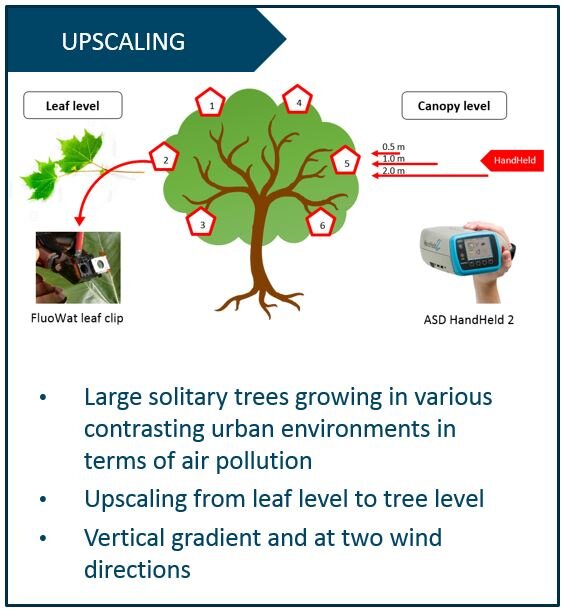Fieldcampaigns during HYPERCITY
The measurements were performed in two study areas: Antwerp (Belgium) and Valencia (Spain). Both were selected because of their variety in land use classes. Antwerp is located in a mild sea climate in contrast to Valencia which is located in a Mediterranean climate regime.
Sampling
As species of interest, plane trees (Platanus x. acerifolia) and orange trees (Citrus aurantium ) were selected. The major selection criteria for these urban trees are their abundance in the study area, contrast in leaf characteristics (especially in terms of dorsi-ventral leaf asymmetry), tree eco-physiological and architectural characteristics and a positive experience and bio-indicator potential gained in previous projects. Furthermore, orange tree was selected as evergreen species to understand temporal variation over different growing seasons. Sampling was performed spatially distributed over different pollution classes: at high traffic roads, in residential areas and in urban parks.
Measurements
On eight leaves per tree, passive hyperspectral measurements were performed using the FluoWat leaf clip coupled to an ASD spectroradiometer. Additionally chlorophyll fluorescence was actively measured using fluorescence images (Fluorescence Imaging System FIS, developed at the university of Hasselt, Belgium), the Plant efficiency analyser (PEA) and Pulse Amplitude Modulation (PAM). All measurements were performed on the ad- and abaxial leaf side.
As biochemical leaf characteristics specific leaf area, leaf water content, chlorophyll content and nitrogen content are measured. These structural leaf parameters will help to interpret the leaf spectra. To study structural changes of palisade- and sponge parenchyma induced by traffic air pollution and inter-canopy variation, leaf cross-section coupes were made. Saturation Isothermal Remanent Magnetization (SIRM), a magnetic leaf biomonitoring approach, was used to map the background pollution at each tree location.


